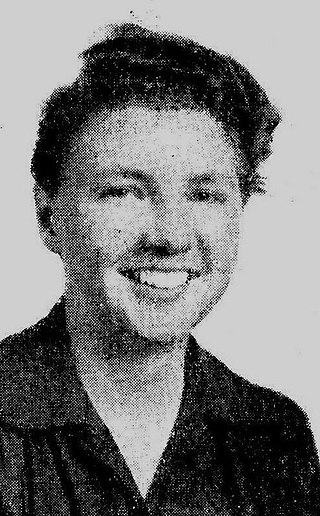
Leigh Douglass Brackett was an American science fiction writer known as "the Queen of Space Opera." She was also a screenwriter, known for The Big Sleep (1946), Rio Bravo (1959), and The Long Goodbye (1973). She also worked on an early draft of The Empire Strikes Back (1980), elements of which remained in the film; she died before it went into production. In 1956, her book The Long Tomorrow made her the first woman ever shortlisted for the Hugo Award for Best Novel, and, along with C. L. Moore, one of the first two women ever nominated for a Hugo Award. In 2020, she won a Retro Hugo for her novel The Nemesis From Terra, originally published as "Shadow Over Mars".

Stanley Grauman Weinbaum was an American science fiction writer. His first story, "A Martian Odyssey", was published to great acclaim in July 1934; the alien Tweel was arguably the first character to satisfy John W. Campbell's challenge: "Write me a creature who thinks as well as a man, or better than a man, but not like a man." Weinbaum wrote more short stories and a few novels, but died from lung cancer less than a year and a half later.

Jupiter, the largest planet in the Solar System, has appeared in works of fiction across several centuries. The way the planet has been depicted has evolved as more has become known about its composition; it was initially portrayed as being entirely solid, later as having a high-pressure atmosphere with a solid surface underneath, and finally as being entirely gaseous. It was a popular setting during the pulp era of science fiction. Life on the planet has variously been depicted as identical to humans, larger versions of humans, and non-human. Non-human life on Jupiter has been portrayed as primitive in some works and more advanced than humans in others.

Saturn has made appearances in fiction since the 1752 novel Micromégas by Voltaire. In the earliest depictions, it was portrayed as having a solid surface rather than its actual gaseous composition. In many of these works, the planet is inhabited by aliens that are usually portrayed as being more advanced than humans. In modern science fiction, the Saturnian atmosphere sometimes hosts floating settlements. The planet is occasionally visited by humans and its rings are sometimes mined for resources.
"The Callistan Menace" is a science fiction short story by American writer Isaac Asimov. It first appeared in the April 1940 issue of Astonishing Stories and was reprinted in the 1972 collection The Early Asimov. It was the second science fiction story written by Asimov, and the oldest story of his still in existence.

"A Martian Odyssey" is a science fiction short story by American writer Stanley G. Weinbaum originally published in the July 1934 issue of Wonder Stories. It was Weinbaum's second published story, and remains his best known. It was followed four months later by a sequel, "Valley of Dreams". These are the only stories by Weinbaum set on Mars.
"Valley of Dreams" is a science fiction short story by the American writer Stanley G. Weinbaum, originally published in the November 1934 issue of Wonder Stories. It was Weinbaum's second published story and is a sequel to his first story, "A Martian Odyssey".
"Parasite Planet" is a science fiction short story by American writer Stanley G. Weinbaum originally published in the February 1935 issue of Astounding Stories. It was Weinbaum's fourth published story, and the first to be set on Venus. He quickly followed it up with a sequel called "The Lotus Eaters".
"The Planet of Doubt" is a science fiction short story by American writer Stanley G. Weinbaum that was first published in the October 1935 issue of Astounding Stories. It is Weinbaum's third story featuring Hamilton Hammond and Patricia Burlingame, a sequel to "Parasite Planet" and "The Lotus Eaters".
"The Lotus Eaters" is a science fiction short story by American writer Stanley G. Weinbaum originally published in the April 1935 issue of Astounding Stories. "The Lotus Eaters" was Weinbaum's fifth published story, and is a sequel to "Parasite Planet".
"Redemption Cairn" is a science fiction short story by American writer Stanley G. Weinbaum that first appeared in the March 1936 issue of Astounding Stories. "Redemption Cairn" is the only Weinbaum story set on Europa.
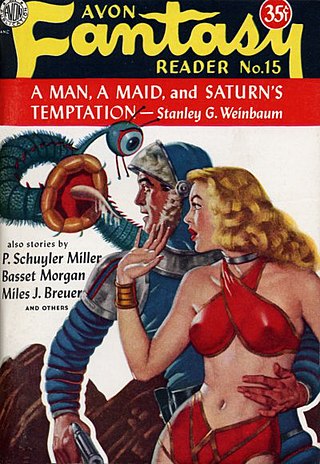
"Flight on Titan" is a science fiction short story by American writer Stanley G. Weinbaum. It was the third story published by Weinbaum in his Planetary Series. Flight on Titan first appeared in the January 1935 issue of Astounding Stories, was the first of Weinbaum's to appear in Astounding Stories, and is the only story by him set on Saturn's largest moon, Titan.
Tweel is a fictional extraterrestrial from the planet Mars, featured in two short stories by Stanley G. Weinbaum. The alien was featured in A Martian Odyssey, first published in 1934, and Valley of Dreams four months later. Weinbaum died of lung cancer soon after, and a third installment in the series never saw fruition. Tweel remains one of the most recognised aliens in early science fiction, and is said to be an inspiration for aliens in the works of Isaac Asimov and Arthur C. Clarke.

"The Red Peri" is a science fiction novella by American writer Stanley G. Weinbaum, which first appeared in the November 1935 issue of Astounding Stories. Sam Moskowitz has noted that Weinbaum planned to write a series of sequels to "The Red Peri" but died before he could do so. "The Red Peri" is the only Weinbaum story set on Pluto. The novel also inspired Arthur C. Clarke, who stated that David Bowman's helmetless spacewalk in 2001: A Space Odyssey was inspired by Frank Keene's escape from the pirate base in "The Red Peri".
"Tidal Moon" is a science fiction short story by American writer Stanley G. Weinbaum and Helen Weinbaum that first appeared in the December 1938 issue of Thrilling Wonder Stories and was reprinted in the collection Interplanetary Odysseys (2006). Sam Moskowitz stated that Stanley G. Weinbaum completed only a page and a half of the story before his death and that his sister Helen Weinbaum completed the story on her own. "Tidal Moon" is the only story by Weinbaum to take place on Ganymede.
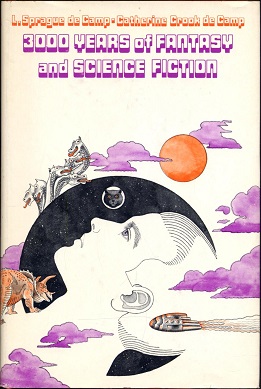
3000 Years of Fantasy and Science Fiction is an anthology of fantasy and science fiction short stories, edited by American writers L. Sprague de Camp and Catherine Crook de Camp. It was first published in both hardcover and paperback by Lothrop Lee & Shepard in 1972. It was the first such anthology assembled by the de Camps, preceding their later Tales Beyond Time (1973).
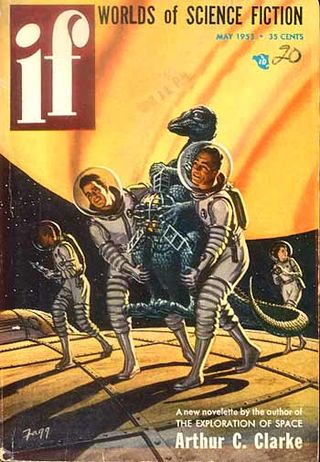
"Jupiter Five" is a science fiction short story by British writer Arthur C. Clarke, first published in the magazine If in 1953. It appeared again in Clarke's collection of short stories Reach for Tomorrow, in 1956, and deals with the detection and exploration of an old spaceship from outside the Solar System.
The Planetary series of stories by Stanley G. Weinbaum is a series of short stories, published in Wonder Stories and Astounding Stories in the 1930s, which are set upon various planets and moons of the Solar System.

A Martian Odyssey and Others is a collection of science fiction short stories by author Stanley G. Weinbaum. It was first published in 1949 by Fantasy Press in an edition of 3,158 copies. The stories originally appeared in the magazines Wonder Stories, Astounding and Thrilling Wonder Stories.
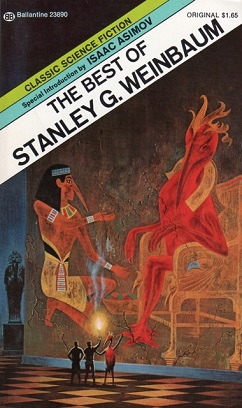
The Best of Stanley G. Weinbaum is a collection of science fiction stories by Stanley G. Weinbaum, published in 1974 as an original paperback by Ballantine Books as a volume in its Classic Library of Science Fiction. The volume included an introduction by Isaac Asimov and an afterword by Robert Bloch. Ballantine reissued the collection twice in the later 1970s; Garland Publishing published a library hardcover edition in 1983, and Sphere Books released a UK market edition in 1977, under the title A Martian Odyssey and Other Stories. The original edition placed third in the 1975 Locus Poll for best genre collection.











